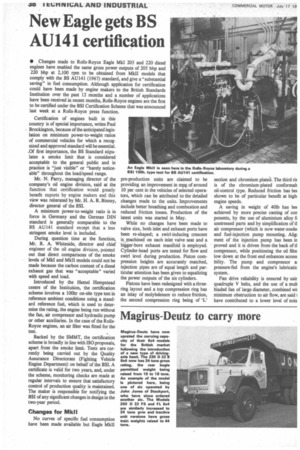New Eagle gets BS AU14 1 certification
Page 40

If you've noticed an error in this article please click here to report it so we can fix it.
• Changes made to Rolls-Royce Eagle MkI 205 and 220 diesel engines have enabled the same gross power outputs of 205 bhp and 220 bhp at 2,100 rpm to be obtained from MkIl models that comply with the BS AU141 (1967) standard, and give a -substantial saving" in fuel consumption. Although application for certification could have been made by engine makers to the British Standards Institution over the past 12 months and a number of applications have been received in recent months, Rolls-Royce engines are the first to be certified under the BSI Certification Scheme that was announced last week at a Rolls-Royce press function.
Certification of engines built in this country is of special importance, writes Paul Brockington, because of the anticipated legislation on minimum power-to-weight ratios of commercial vehicles for which a recognized and approved standard will be essential. Df first importance, the BS Standard stipulates a smoke limit that is considered acceptable to the general public and in practice is "just visible" or -barely noticeable" throughout the load/speed range.
Mr. N. Parry, managing director of the company's oil engine division, said at the function that certification would greatly benefit exports by engine makers and this view was reiterated by Mr. H. A. R. Binney, director general of the BSI.
A minimum power-to-weight ratio is in force in Germany and the German DIN standard is generally comparable to the BS AU141 standard except that a less stringent smoke level is included.
During question time at the function, Mr. R. A. Whiteside, director and chief engineer of the oil engine division, pointed out that direct comparisons of the smoke levels of Mk.1 and MkIl models could not be made because the carbon content of a diesel exhaust gas that was "acceptable" varied with speed and load.
Introduced by the Hemel Hempstead centre of the Institution, the certification scheme involves a 100hr on-site type test in reference ambient conditions using a standard reference fuel, which is used to determine the rating, the engine being run without the fan, air compressor and hydraulic pump or other auxiliaries. In the case of the RollsRoyce engines, an air filter was fitted for the test.
Backed by the SMMT, the certification scheme is broadly in line with ISO proposals, apart from the smoke limit. Tests are currently being carried out by the Quality Assurance Directorate (Fighting Vehicle Engine Department) on behalf of the BSI. A certificate is valid for two years, and, under the scheme, monitoring checks are made at regular intervals to ensure that satisfactory control of production quality is maintained. The maker is responsible for notifying the BSI of any significant changes in design in the two-year period.
Changes for Mk!!
No curves of specific fuel consumption have been made available but Eagle Mk11 pre-production units are claimed to be providing an improvement in mpg of around 10 per cent in the vehicles of selected operators, which can be attributed to the detailed changes made to the units. Improvements include better breathing and combustion and reduced friction losses. Production of the latest units was started in May.
While no changes have been made to valve size, both inlet and exhaust ports have been re-shaped; a swirl-inducing crescent is .machined on each inlet valve seat and a bigger-bore exhaust manifold is employed. Cylinder-head ports are tested for flow and swirl level during production. Piston compression heights are accurately matched, injection pipes are of equal length and particular attention has been given to equalizing the power outputs of the six cylinders.
Pistons have been redesigned with a threering layout and a top compression ring has an inlay of molybdenum to reduce friction, the second compression ring being of 'L' section and chromium plated. The third ru is of the chromium-plated conformab oil-control type. Reduced friction has bet shown to be of particular benefit at high engine speeds.
A saving in weight of 401b has bet achieved by more precise casting of cor ponents, by the use of aluminium alloy ft unstressed parts and by simplification of tl air compressor (which is now water-cooleo and fuel-injection pump mounting. Alig, ment of the injection pump has been in proved and it is driven from the back of ti compressor, while positioning the oil flute low down at the front end enhances access bility. The pump and compressor a pressure-fed from the engine's lubricatic system.
Fan drive reliability is ensured by usir quadruple V belts, and the use of a mull bladed fan of large diameter, combined wii minimum obstruction to air flow, are said have contributed to a lower level of nois








































































































